Please ensure you have images turned on to see this page as intended or you can view online |

|

|

|
Happy Christmas To You AND...
|

|
|
In addition to the usual stuff in my ezine, I wanted to say a few words as the year draws to an end.
I used to complain and tut each Christmas dinner time when my Father made us all bow our heads at the table and say Grace. He'd remind us of how privileged we all were to be with friends, family and loved ones and to be eating so well when so many others were not so fortunate. Not having thanksgiving here in the UK, it is really Christmas that we get to focus on it if we have not been doing so already.
I am so thankful to be working in my chosen field of work and to be earning a living from it. I give thanks for having so many close friends and colleagues for whom I truly admire, respect and love within my field of work. Importantly today, I am truly appreciative and thankful to you - my regular readers and those who follow my work.
This past year has been hard for so many of our regular readers for a wide variety of reasons. Many of you have had a struggle with the economic climate. Many of you have experienced big change of some kind. Many of you are making plans for a new direction in life. I know this because I hear from so many of you each and every week when this ezine goes out.
You are very much appreciated by me. Thank you for reading each week. Thank you for your continued enthusiasm for what we offer here and I hope that in 2013 we'll continue to offer much of value and enjoyment to you.
I wish you and your families a most wonderful and enjoyable festive season.
I send you much love.
Adam.
|

We Have Some Special Happenings Ready For 2013
|
Hello , and welcome to this week's Adam Up, the last edition of Adam Up for 2012! We'll not be back (at least in this format) until January and will allow you to get on with your festive season. When we come back in January, we have some major plans...
Look out, because we plan to start running into 2013 on a very high, healthy note. (there is a clue in that sentence) - Before I crack on this week, as announced first last week, I have some big news I want to share with you, but you'll have to read about it
here at my website:
It tells you about some major personal changes happening in my life and the reasons I am running even more marathons next year...
Plus, if you are a hypnotherapist, you can come and join us for a charity hypnosis extravaganza.
|
Do You Want To De-Stress Your Christmas?
|

|
|
Onto this week's Adam Up then.
With the festive season upon us, I think a lot of people eat a lot, drink a lot and get incredibly busy.
SOOO busy.
It can actually be an incredibly stressful time for many.
Naturally, I tell people to use self-hypnosis for relaxation and there are some people who just don't seem to understand how much good it can do them to use hypnosis for a very specialist kind of relaxation that is so healthful, AND it'll put an end to festive stresses.
As I have written before, many people in the field of professional hypnosis and hypnotherapy get worried, concerned, and sometimes even frustrated by the seeming similarity between hypnosis and relaxation. I say 'frustrated' because some people assert that hypnosis and relaxation are totally different and quite rightly so.
There are however a very large number of studies out there, in particular the work of Edmonston (1981 & 1991) that shows that relaxed clients in the therapeutic environment are just as responsive to suggestions as clients who are hypnotised and given suggestions.
Banyai (1991) writes about and builds upon his earlier work from the 1970s with Ernest Hilgard, whereby he showed that by having a client exercise vigorously for a period of time prior to a hypnosis session, the client could still be hypnotised, but would not be at all relaxed. In fact, they would be alert and focused and have a heart rate and pulse that was very active and alive! A client undergoing relaxation training in any form of psychotherapy would not gain the benefits of the relaxation in the same way, making the two quite different.
There are other studies that bear out this notion and can be found from a variety of sources.
As often seems to be the case, many people wrongly suppose that hypnosis is simply relaxing and many people perpetuate the myth and it comes to be thought of as having relaxation inherent within it. This is not the case.
Hypnosis can be used to develop relaxation though, and it can be used to enhance relaxation to ensure we derive much benefit from relaxing. In fact, studies have helped us to recognise how a profound physiological state of deep rest can be created by suggestion and hypnosis. This is particularly interesting and important when you consider that, as Platonov (1959) showed, that natural sleep does not always completely rest all of our bodily functions and organs.
When we look at the origins of hypnosis, James Braid originally termed it "neuro-hypnotism" meaning "sleep of the nervous system." Braid's early use of hypnosis was to induce a deeply relaxed state, which vaguely resembled sleep, but the individual being hypnotised had a conscious awareness of it.
When we see that some individuals derive a seemingly more profound benefit from the relaxation achieved alongside hypnosis sessions, it makes sense to learn how to do this and benefit from it ourselves, doesn't it? That is what this blog entry is all about.
Lots of people I have worked with report that they find the process of structured self-hypnosis sessions, and everything involved within it, to be quite stimulating. Likewise, a number of researchers have also noticed that many of the processes involved in self-hypnosis can have a stimulating effect on the self-hypnotist - such as mental imagery, focusing, making suggestions using internal dialogue and so on.
Many of things require effort and too much effort can create an impediment to successful self-hypnosis, heck it can even sometimes cause anxiety, which impedes progress greatly.
The previously mentioned Edmonston (1981 & 1991) published a very thorough review of hypnosis and relaxation and wrote about the use of hypnosis without any specific suggestion or mental imagery or cognitive strategies which is sometimes terms "neutral hypnosis" and is ideal for generating a profound level of hypnotic relaxation due to the absence of stimulation or distraction that these things can sometimes present.
Some of the research highlights a major contribution to this topic of Platanov and other former Soviet Union researchers. Relaxation was often synonymous with hypnosis and in some cases formalised hypnosis was preceded by an hour of lying down relaxing in a darkened room - which really curtailed distractions and stimulation, but may not win favour in therapy rooms of today. (I mean, do you have clients that would be prepared to start their therapy sessions off by sitting in your darkened therapy room for an hour on their own before you start?) Sometimes after treatment, having given corrective suggestions, they would then instruct the client to drift to sleep again and leave them for an hour again.
Platanov (1959) discusses conditioning in hypnosis, as influenced by much of the earlier work of Pavlov. He showed that the activity of the cortex and subcortex are different during states of waking and suggested sleep. So we are going to build upon the notion of suggested sleep to advance our relaxation here within this process today.
|
Specialist Relaxation Skills For The Festive Season
|
|
Prior to starting with the step-by-step process I am offering up here, make sure that you frame the hypnotic relaxation session in such a way that you are aiming to relax deeper than you are usually capable of doing. Platanov suggested that in some ways, hypnotic relaxation offered up more health benefits and usefulness than natural sleep. It is certainly going to offer up a variety of health benefits if practiced regularly.
You should aim to have a minimum of 10 minutes to invest in this, though ideally a fair bit longer as you practice more aiming to gain the major benefits from it (20-30 minutes). You'll also want to make this part of a regimen that you put together and practice daily for at least 2-3 weeks to derive the benefits from it and to build up and ability to do this for longer thereafter.
Find a comfortable seated position to be in with your feet flat on the floor and your hands not touching each other. If your intention is to use this to drift off to sleep, then you'll want to be lying down in bed, however, to gain the full benefits of hypnotic relaxation, you do not want to fall asleep. You associate lying in bed with sleep, so unless that is your aim, do this seated.
Throughout the upcoming process, remember your goal is to relax deeply and ideally deeper than usual. Therefore, whenever possible, convince yourself gently that you are relaxing, adopt the position and behaviour and thought patterns of someone who is deeply relaxed and help yourself along with the process - without trying and without exerting effort, just gently assuming you are relaxing and doing this beautifully well. Imagine that you are completely relaxed throughout and let your imagination help you along.
These steps given here are very similar to the relaxation process involved with the hypnotic systematic desensitisation I use in my clinical practice; just without the exposure, and the steps are supported with research to support their efficacy and benefit to the recipient.
With all that preparation complete, now follow these simple steps:
|
|
Step Two: |
|
Once you have induced hypnosis, you want to initiate the relaxation response. Whatever active component you used in your induction (eyelids, arms etc) you can imagine that area becoming totally relaxed. Start to let your breathing happen automatically - that is, stop interfering with it, just observe it and let your body breathe by itself. Don't try to change it and don't try to stop it from changing.
As you relax, your body will require less oxygen, so your breathing may become lighter and shallower, just let that happen.
Using your imagination, just imagine your entire body settles and relaxes with your breathing for a few minutes. Just let thoughts happen, let your breathing happen and imagine relaxing and gently settling and then move on the step three.
|
Step Three:
|
Now you are going to use a progressive relaxation process.The aim here is to spread relaxation into various parts of your body. As you get better at doing this, you can start to focus on more specific and smaller parts of the body, something referred to by hypnotherapists and fractionation. Here are some ideas of how to do this:- a) Use your internal dialogue and simply tell yourself that each part of your body is relaxing. For example "my toes are relaxing deeper... and now my ankles... moving into my lower legs..." and so on.
b) As you work your way through your body, you may like to use a colour or light or imagined warming sensation and spread that through the muscles and imagine the colour (ideally one you associate with relaxing) spreading through the muscles as you reach each part of your body.
c) Additional cognitions. Richard Bandler uses the word "soften" as he relaxes parts of the body. He focuses on each muscle and then says "soften" as he works through, you might like to do the same.
d) You may imagine a relaxing sound moving through your body.
e) You may imagine the muscles limp, loose, dormant; maybe like a loose rubber band, or a rag doll, or whatever else you can imagine to indicate the relaxation spreading. i learned a great technique from Terrence Watts who suggested imagining the body as a candle and as the candle softened and got warm and liquid-like, so the muscles of the body got warm and softened and so on.
Ideally, use a combination of these elements. Bask in the relaxation you create, enjoy it and enjoy this time as well spent. You may like to repeat this step a couple of times to make sure you develop the progressive relaxation as much as possible.Once you have done so, move on to the next step.
|
Step Four:
|
|
Use your internal dialogue and start to count downwards with each breath that you exhale. You might imagine the numbers in your mind, or simply say it with your internal dialogue.
After each number, say the words "relaxing deeper" too. Say it in a highly relaxing tone and manner to yourself, so there is no hint of effort, just gently assume it is happening, counting downwards as you exhale and all the time focus on being deeply relaxed.
Tell yourself and imagine that on each number you count, you are relaxing deeper into profound hypnotic relaxation.
When you reach zero, move on to the next step.
|
Step Five:
|
The next step is to fix your attention and focus onto a single ongoing and repetitive train of thought. You will use the idea and belief of being highly and deeply relaxed.You can do this in a number of ways:- Continue to say certain words upon each breath you exhale. Such as "deeper" or "more relaxed." Use whatever word you find to be most relaxing to you.
-
Focus on your breath; you might count your breaths and keep going. Do not alter your breathing, just count each breath as it happens and if you lose track of your counting, simply start from 1 again and see how long you can continue to be aware and keep tuned in before your mind wanders. Do this without challenging yourself, and without effort. Just accept it calmly if you lose count and start again. Enjoy the counting.
You can also simply follow the movement of your breathing, maybe just watching the ribs expand, or the chest rise or noticing the change of temperature in the nostrils as you inhale and exhale and watch your breathing that way instead. Tuning into it and letting it consume your attention and train of thought.
-
Enjoying relaxing sensations. Simply notice somewhere about your body that is relaxed, notice what tells you it is relaxed and then watch those sensations start top spread to other parts as well. Again, bringing your awareness back to it if it wanders.
Whichever of these you use, keep a fixed train of thought for the remaining time you have allotted to this. Keep encouraging your self, keep assuming it is working, being progressive and positive with yourself and engage in a gentle, easy way without ever 'trying' or getting anxious or worrying about anything. Simply enjoy it lazily with utmost relaxation of the body and keeping your awareness and focus in place.
When you have done this for the remainder of your allotted time, move on to the final step.
|
Step Six:
|
|
Take a couple of deeper, energising breaths, wiggle your toes and fingers and open your eyes and bring this session to an end.
As with so many of the processes I share here, you'll derive more benefit from focused practice and developing your skill (and thus your self-efficacy) with this. Be aware that you can be physically relaxed while your mind races and you can be physically active while your mind is still and quiet (I swear I am at my most peaceful when running marathons) - this process addresses both; you get to relax the body first and then ease the thoughts and feelings you have by engaging in the continuous train of thought, engaging in repetition to still and quiet the mind and relax.
Practice and enjoy getting some deep hypnotic relaxation into your daily routine, the benefits are vast and you'll be pleased you did it.
|
References: |
|
Banyai, E. I., Hilgard, E. R. (1976). A comparison of active-alert hypnotic induction with traditional relaxation induction. Journal of Abnormal Psychology, 85(2), 218-224.
Edmonston, W. E. (1981) Hypnosis and Relaxation: Modern Verification of an Old Equation. pp.127-240. John Wiley and sons.
Lynn, S. J., and Rhue, J.W. (1991) Theories of hypnosis: Current models and perspectives: pp.564-598. Guildford Press.
Platonov, K. I. (1959). The word as a physiological and therapeutic factor: The theory and practice of psychotherapy according to I. P. Pavlov. ( 2nd). Moscow: Foreign Languages Publishing House.
.
|
|

People Are STILL Buying Our Products At Full Price - Share And Get Rewarded
GET HALF PRICE COUPON BEFORE YOU PURCHASE
|

|
IMPORTANT TIP:
Share with your Facebook or Twitter followers BEFORE you
purchase and get the coupon code to save you money.
Now you can get any of Adam's Audios or Videos for sale in our store
INCLUDING SPECIAL OFFERS
at HALF PRICE.
How?
All you have to do is go to the store and access any product
and open the detail sales page. AND Click on the Share Button (see example below). Then click on Facebook
or Twitter or Pinterest or EMail
and you will receive a 50% Discount Coupon
which you can use as often as you like
The current level of reward (ie 50%) for sharing information
with your friends will remain until the end of the year.
|
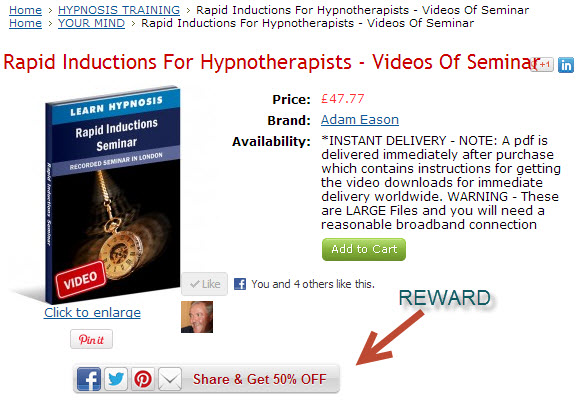
|
DECEMBER SPECIAL OFFER
Bundle Of Six Of Adam's Audios
SELF-IMPROVEMENT PACKAGE
|

|
REMEMBER TO SHARE FIRST AND GET THIS BUNDLE FOR JUST £9.87
|

|
Joke Of The Week |
I got back from town this morning to find all the windows smashed in and everything taken. What kind of person does that to your advent calendar?A festive rib tickler for you. Thank you to everyone for all the jokes you people send in, keep them coming and lets keep laughing. We do have a group dedicated to jokes and funnies in the new hypnosis hub
, so come and read the stuff that goes on there.
|
|
Hypnosis Hub Forum |

|
Please do come and join us in the new Hypnosis Hub, - if you are a professional in the field, you'll get more business using this forum,
- if you are curious the hypnosis field, you'll learn more,
- if you are student of hypnosis and hypnotherapy, you'll get support and resources...
|
|

|
Hypnotherapy Diploma Training |

|
If you want to train to be a hypnotherapist, there has never been a better time, we are thriving in this economic climate! If you'd like to train, check out here for a course prospectus, dates and application form for this year's diploma, fully approved and accredited in several countries...
The spaces are going at some pace right now though... My training school is one of a few in the UK to currently offer the externally verified HPD (Hypnotherapy Practitioner Diploma) which matches government occupational standards and is the equivalent of National Vocational Qualification (NVQ) level 4
|
|
|

|
Learn Self-Hypnosis!
We have new dates for my self-hypnosis one day seminar.
They also carry with them Continued Professional Development (CPD) credits with the GHR and NCH here in the UK if you are a member of either.
The seminars have been fully booked up this year and we are offering these extra dates in response to popular demand.
|
|

|
NEW COURSE - 5 Day Intensive Certification in Cognitive Behavioural Hypnotherapy in 2013 |
|
|
And.... |
Please remember to tell friends, family, colleagues and anyone else you know how they can receive Adam Up each week and let them know that they get a free hypnosis session, a five day personal development course and a 50,000 word eBook 'The Happy Brain Manual', when they register from my homepage. If you are on Twitter, I publish some absolute gold material if you are interested in the fields of hypnosis, hypnotherapy and self-hypnosis, do come and follow me: http://twitter.com/adameason
Do come and join us in the members area if you wish to learn more, I mean much more about the fields of hypnosis, hypnotherapy and self-hypnosis. There's over 60 hours of video footage, even more audio material, hundreds of articles to read, and lots of free eBooks too. You get massive savings on all my audio programmes in there too. Our Platinum Section is revamped and relaunched
and now has many hours of training and tuition video from my diploma course, go have a read about it. I'll be back in the New Year ...
In the meantime, enjoy advancing your self-hypnosis skills with ispecialist relaxation ...
I thank you for reading...
Goodbye for now.
|
|

|
|
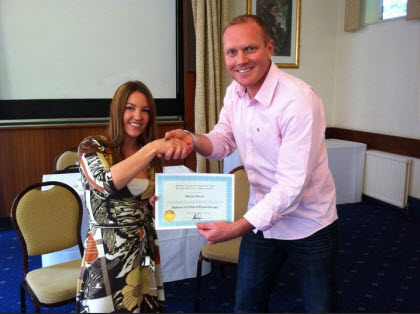
|
MELANIE RIVERA
Having just completed Adam's 10 month diploma course and thoroughly enjoyed it, it brings me great pleasure to write this review. I just want to say that if you have decided that you would like to embark on a career in hypnotherapy; and you are now at the stage of deciding on the right training school for you...
Search no more, Adam's course in my mind is the best of the best! From beginning to end you will be hypnotized by the way in which Adam delivers his course material to you. I found Adam to be a very fun and charismatic guy; he will have you in stitches laughing! He is a brilliant teacher, very clear and easy to understand. For me the whole course has been like a personal journey towards a successful ending. Adam demonstrates many of the techniques so you really get to sample how talented he is as a hypnotherapist. I have to say that on more than one occasion when Adam did a class demonstration; I noticed some big changes take place in my own confidence and in the rate of my learning... I put down this down to benefiting from being in deep hypnosis myself during his demo.
Adam is very attentive and very observant, he doesn't miss a trick. He seems to distribute his attention towards each individual at the right time, as a result you really feel like you get a very personalized learning experience. I might add that this course isn't a 'cake walk'... Prepare to 'work your socks off!' In terms of homework, you really have to be committed and keep on top of it. I can honestly say that it is all worth it and, having completed Adam's course, I do feel competent enough to embark on my career as a hypnotherapist.
|

|
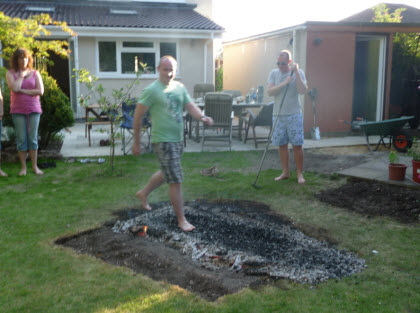
|
GARETH MORGAN
(pictured here firewalking) Adam is unique trainer or, as I like to think now, my mentor. With a perfect balance of seriousness and fun mixed together, he creates an enjoyable and learning atmosphere which keeps you wanting more. I spent over a year looking at different courses and chatting to other trainers and I can honestly say that I made the best choice that was right for me.
Adam's knowledge and passion for the subject surpasses that of anyone else I have met in this field, and Adam is very generous with his sharing of that knowledge. It is obvious from the beginning that Adam knows what he's doing and that you have made the right choice in joining the course. Prepare to amaze yourself in the things you know and can talk about with others confidently as you progress through the course, I did and I still do today. If you want an enjoyable learning experience with a trainer that really does want you to be the best you can be, then take that next step. To sum up the course in three words, Creative, Enjoyable, Diverse.
|

|
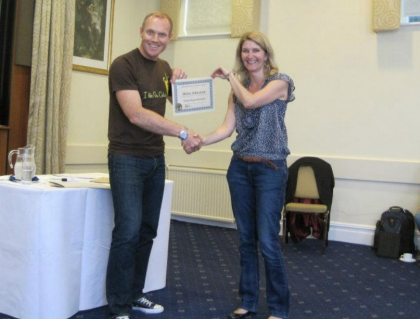
|
HELEN JOHNSTONE "I attended the 10 month course which ran from October 2011- July 2012. The course is interesting, fun, fast paced, encouraging, confidence building, skill packing and very professionally run by Adam and his team. Realistically, it required a lot of committment in time and effort, which in reality was easy to give with the knowledge and new zest for learning that Adam's enthusiasm brings. Adam and his team were of constant support to me throughout the course and I feel lucky to be able to consider them to be good friends and confidantes now.
I have qualified and feel confident that the knowledge,confidence, skills and practical experience I have gained during this course will serve me very well in practice"..
|

George Watson |
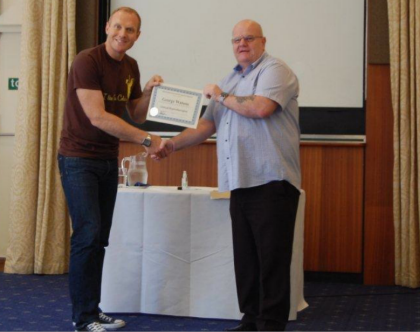
|
GEORGE WATSON - GLENROTHES, FIFE, SCOTLAND "I booked up to Adam Eason School of Therapeutic Hypnosis in 2010, and I really did not know what to expect, I was very interested in Hypnosis, but what is taught throughout the diploma course is by far the best around. Adam's very unique style is very uplifting and thorough and I leave his school with much more knowledge and well trained in clinical hypnotherapy. If you want trained to the high standard that Therapeutic Hypnotherapy should attain then look no further than Adam's School" |
|

|
Skype |
Another thing that we encourage is contacting us via Skype. Keith's Skype ID - keithaw2k1. For example if you would prefer to pay for products or services by using a debit or credit card then you can contact Keith to make your payment. |
|
|
|
|